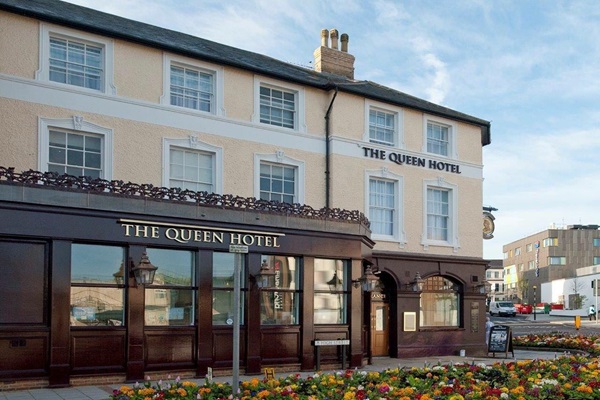1 High Street, Aldershot, Hampshire, GU11 1BH
This long-standing local landmark dates from the early years of Queen Victoria’s reign, when Aldershot was rapidly developing into an army town, which it is still is today. This hotel was first licensed in 1857. Horatio Tuddenham was its landlord. He ran the hotel with his wife, Hannah, for its first few formative years.
A photograph and text about The Queen Hotel.

The text reads: The Queen Hotel was formerly known as the Queen’s Inn and construction started in 1885, by a contractor called Hemmings who was building the North Camp Barracks in Aldershot. It was built opposite the gateway to the East Cavalry Barracks and was first licensed in 1857, at which point it was owned by Horatio and Hannah Tuddenham.
Aldershot is situated in North East Hampshire on the border with Surrey and due to its elevated height can be seen for many miles. Long before written records began there is evidence of human activity in the local area, there are two prehistoric earthworks, the first is known as Caesar’s Camp which dates back to the Iron Age and Batt’s Hog Stye is a Roman Intrenchment, probably the site of an early Celtic Chieftain’s homestead. The earliest recorded mention of Aldershot occurs in King Alfred’s will dating from the early 880s, in which he left the Hundred of Condrall to his nephew. The village of Aldershot formed part of his bequest. The Hundred of Crondall was a strategic collection of villages and land with a meeting place where the wealthy and powerful would convene as required, it came to hold high level Hundred Court proceedings. In 975 King Edgar granted the Hundred to the monastery of Winchester Cathedral.
By the early/mid-19th century Aldershot was one of the most pleasing and picturesque hamlets in England, it consisted of a church, two important houses, Aldershot Manor and Aldershot Palace, as well as a village green and a few farm houses. The Parish Church dates from the 12th century, but is pre-dated by an even earlier building. The original Manor House was built in the 1400s, however the current swelling dates from 1670.
In 1851 there were 875 inhabitants of Aldershot, with the main occupation being agriculture. There was also the Union School which served the poorer children of the wider area, which had 100 scholars, forming a large part of the census. At this point the village of Aldershot was self-sufficient with a baker, butcher, grocer, blacksmith, wheelwright, veterinary surgeon and three carpenters. There was a large cluster of houses around the village green, which still exists today.
In 1853 life in Aldershot changed dramatically when the Royal Engineers arrived to set up camp. Aldershot was chosen as it was mid-way between London and the naval port of Portsmouth and as it also had good rail links. By 1861 the census showed a very different picture, Aldershot had become a burgeoning Victorian Town, with mainly very young residents. The population was nearly 5,000 with the main occupation being publican or boot maker. The huge increase in the population brought some problems to the area, there was a huge increase in drinking dens, there was poor sanitation and many residents succumbed to disease.
The East Cavalry Barracks were built to house the 3rd Dragoon Guards, the barracks were later named the Warburg Barracks, and they were located at the top of the High Street, these barracks were demolished in the 1960s and the site is now a shopping and leisure centre, opposite The Queen Hotel. The Royal Pavilion was built around this time, a temporary residence for Queen Victoria for when she came to visit the troops, she first visited in 1855. By the 1860s a degree of Victorian respectability had settled on the rapidly developing town. There was the establishment of many churches in the town during this period, including the Presbyterian Church, Methodist Church, and the Holy Trinity Church. In addition to this many schools were opened with one in the East End and one in the West End of the Town.
By the 1890s the population had increased to around 25,000. The Local Government Act of 1894 created the Aldershot Urban District Council, giving the town more control over its own destiny. For example, making a decision to install electric street lighting. In 1893 Gale and Polden came to the town, built a factory and printed the first edition of the Aldershot News, the paper then continued for the next 90 years.
External photograph of the building – main entrance.

If you have information on the history of this pub, then we’d like you to share it with us. Please e-mail all information to: pubhistories@jdwetherspoon.co.uk